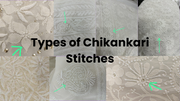Embroidery has long been celebrated as a form of artistic expression, and few styles capture the essence of tradition and elegance as gracefully as Chikankari. Originating from the historic city of Lucknow in India, Chikankari is renowned for its intricate stitches and delicate motifs that adorn fabric with timeless beauty. At the heart of Chikankari lie its stitches, each one a testament to the skill and artistry of the embroiderer. From the basic yet essential Tepchi stitch to the ornate Phanda and Murri stitches, each stitch carries its own significance, contributing to the intricate tapestry of designs that define Chikankari embroidery. In total there are 32 stitches in chikankari but we'll be looking at only 7 important ones here.
In this exploration, we embark on a journey through the enchanting world of Chikankari stitches, unraveling the techniques and nuances that distinguish this revered art form. Join us as we delve into the rich heritage and meticulous craftsmanship behind each stitch, celebrating the legacy of Chikankari embroidery and its enduring allure.
Chikankari Stitches Information:
| Stitch Name | Description |
| Tepchi or Straight Stitch | Basic running stitch worked in parallel lines, forming the foundation of Chikankari. |
| Bakhiya or Shadow Work | Stitch creating a shadow effect by intertwining threads on the fabric surface. |
| Zanzeera or Chain Stitch | Chain-like stitch used for outlining motifs and creating decorative borders. |
| Keel Kangan or Stem Stitch | Twisted stitch often used for outlining motifs, resembling a rope-like texture. |
| Phanda or Knot Stitch | Small raised knots adding texture and dimension to the fabric surface. |
| Murri or French Knot | Tiny knots creating textured effects, enhancing the visual appeal of Chikankari designs. |
| Hool or Eyelet Stitch | Delicate holes punctuated with stitches, lending an intricate lace-like appearance to the fabric. |
Tepchi or Straight Stitch:

The Tepchi stitch is the fundamental stitch in Chikankari embroidery, forming the basis for many intricate designs. It involves creating parallel lines of simple running stitches, typically worked from right to left. This stitch provides the foundation upon which other stitches and motifs are built, offering versatility in creating both subtle textures and bold patterns. Despite its simplicity, the Tepchi stitch requires precision and attention to detail to ensure uniformity and neatness across the fabric. It serves as a cornerstone of Chikankari embroidery, embodying the tradition and artistry that define this timeless craft.
Bakhiya or Shadow Work:

Bakhiya, also known as shadow work, is a distinctive stitch in Chikankari embroidery that creates an enchanting illusion of depth and dimension. This technique involves the clever interplay of threads, where the embroidery is done on the underside of the fabric, and the design appears as a shadow on the surface.
The process begins by drawing the needle and thread through the fabric, creating small stitches on the surface. Then, the thread is looped back and forth, securing it to the fabric while creating a series of tiny knots that form the shadow effect. The result is a delicate play of light and shadow, adding a captivating allure to the embroidered motifs.
Bakhiya stitch is often used to outline intricate patterns and motifs, lending a subtle yet mesmerizing texture to the fabric. It is a testament to the skill and craftsmanship of the artisan, requiring precision and attention to detail to achieve the desired effect.
Zanzeera or Chain Stitch:

Zanzeera, also known as the chain stitch, is a fundamental element of Chikankari embroidery, celebrated for its elegant and decorative appearance. This stitch is characterized by a series of interconnected loops that resemble a chain, hence its name. Artisans skillfully create this stitch by forming a loop with the thread and securing it with a small anchor stitch, allowing the loops to flow seamlessly along the fabric's surface.
One of the distinctive features of the Zanzeera stitch is its versatility. It can be used to outline motifs, create intricate borders, or add embellishments to Chikankari designs. The chain-like pattern formed by this stitch adds a sense of fluidity and grace to the embroidered fabric, enhancing its overall aesthetic appeal.
Keel Kangan or Stem Stitch:

The Keel Kangan stitch, also known as the Stem Stitch, is a classic embroidery technique characterized by its elegant, twisted appearance resembling a rope or stem. In Chikankari embroidery, this stitch is often used for outlining motifs, creating borders, and adding definition to intricate designs.
To execute the Keel Kangan stitch, the needle is brought up through the fabric, and then a small stitch is made, followed by bringing the needle back down slightly ahead of the initial point. This process is repeated, with each stitch slightly overlapping the previous one, resulting in a continuous line with a twisted effect.
The Keel Kangan stitch lends a sense of grace and sophistication to Chikankari pieces, enhancing the beauty of the embroidered motifs and adding depth to the overall design. Its versatility makes it a staple stitch in the repertoire of Chikankari artisans, allowing them to create intricate patterns with finesse and precision.
Phanda or Knot Stitch:

The Phanda stitch is a hallmark of Chikankari embroidery, known for its intricate and delicate appearance. In this stitch, small raised knots are created on the fabric surface, adding texture and dimension to the embroidered motifs. These knots are formed by wrapping the thread around the needle multiple times before pulling it through the fabric, resulting in charming spherical shapes that adorn the design. The Phanda stitch is often used to fill in small spaces within larger motifs or as decorative accents, lending a whimsical and tactile quality to Chikankari embroidery.
Murri or French Knot:

The Murri stitch, also known as the French Knot, is a decorative stitch characterized by small, tightly wound knots created on the fabric surface. These knots are formed by wrapping the embroidery thread around the needle multiple times before inserting it back into the fabric close to the point where it emerged. The result is a textured, three-dimensional dot that adds depth and visual interest to Chikankari embroidery. Murri stitches are often used to fill in small spaces within motifs or to create intricate patterns and accents.
Hool or Eyelet Stitch:
The Hool stitch, also known as the Eyelet stitch, is characterized by delicate holes punctuated with stitches, creating an intricate lace-like appearance on the fabric. This stitch involves carefully creating small eyelet-like openings in the fabric, which are then outlined or embellished with additional stitches. Hool stitch adds a touch of elegance and sophistication to Chikankari embroidery, often used to create intricate patterns, floral motifs, or decorative borders. Its meticulous craftsmanship and intricate detailing make it a hallmark of traditional Chikankari designs, adding depth and texture to the fabric surface while exuding timeless beauty.
Conclusion:
Each of these stitches holds a unique charm, allowing artisans to weave stories of tradition and craftsmanship into every Chikankari masterpiece. Incorporating these stitches not only preserves the heritage of this revered art form but also ensures that each creation stands as a testament to the timeless beauty of Chikankari embroidery. Discover the allure of Chikankari and indulge in its intricate stitches, where tradition meets contemporary elegance.


